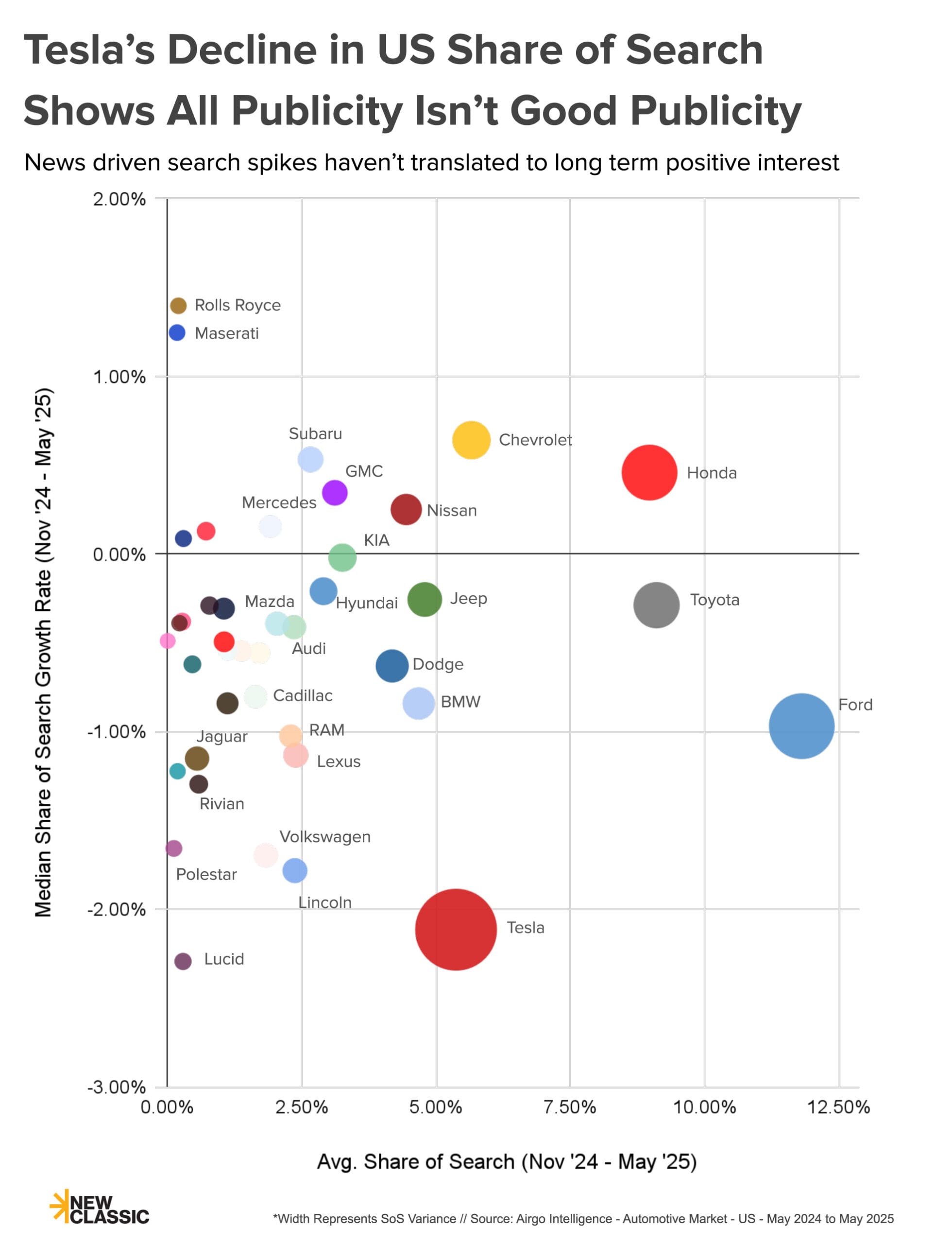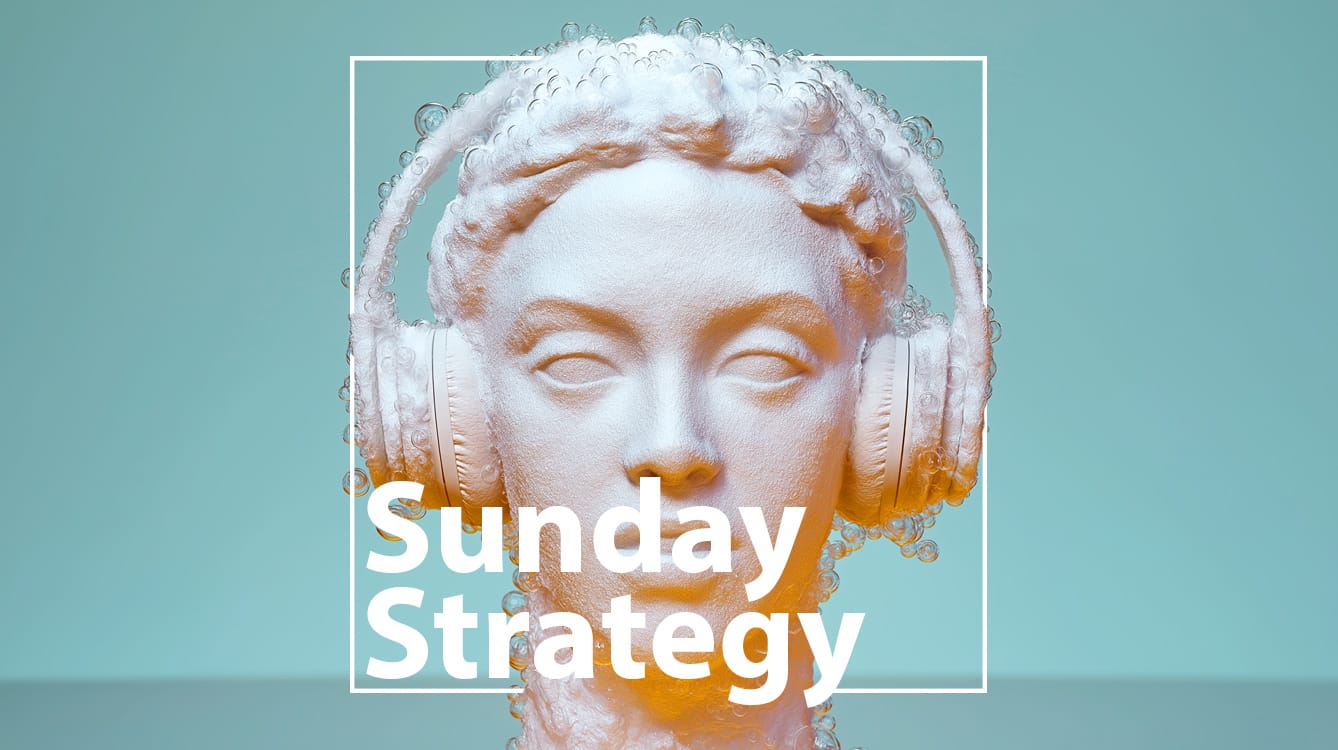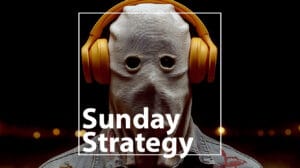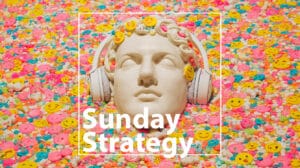In this issue of Sunday Strategy, we look at five stories to think about next week, including: Weird Ads & Sydney Sweeny’s Bathwater Soap, AI Panic at the White Collar Disco, Southwest Airlines Ditches Brand Distinctiveness, AI Interviewers and a Shift in iOS Naming.
In addition, we have ads from: Tesco, Old Navy, Oura, Oscar Meyer and O2.
// Five Stories of the Week:
1.) Is Weird Advertising Dying? Ask Sydney Sweeney’s Bathwater Soap.
Here’s a piece of hope for anyone who laments the death of weird advertising. Soap brand Dr. Squatch and actress Syndey Sweeney have extended last year’s campaign with a new activation that goes in a surprising direction – selling soap with bubbles from her bathwater. The PG Saltburn style move has sparked controversy for both the actress, who says the move and previous campaign help to take back her image and the brand, known for its more natural ingredients.
Seemingly borrowing a page from Liquid Death’s collaboration and stunt model, Dr. Squatch’s bathwater soap, available for sale in limited amounts and through give away, highlights that advertising can still surprise and get weird in ways you wouldn’t expect. While brands like Liquid Death have made an entire image around the unexpected, unbound from anything that would hold it back, Dr. Squatch’s move shows that even those with a holistic heritage can still get quirky.
The risk is higher for Dr. Squatch, which is perhaps why we see this as an evolution of their previous campaign – iterating further past the envelope in a way that looks risky, with less risk. In an age where we lament creativity’s decline, you have to appreciate Dr. Squatch’s idea, even if you wouldn’t hop in the tub with it.
2.) AI Panic at the White Collar Disco
Dario Amodei, the CEO of AI firm Anthropic, has recently suggested that AI could wipe out half of entry level white collar jobs in the next one to five years, with a knock on effect that takes unemployment to 10-20%. The prediction is terrifying, but also one that is hard to put into context, as a shift of 9m jobs (assuming 18m of the 48m white collar jobs that exist in the US would be affected) is a seismic one.
Government regulation, as Amdoei points out, is much more focused on tech supremacy against China than it is mitigating the economic impact of AI on workers. This oversight, coupled with the existing chaos in the job market and competition between tech firms, makes Amodei’s predictions more tangible to some degree.
So can anything be done? Preparing to mitigate AI’s impact doesn’t necessarily mean you buy into the worst case scenario for it, but it is pragmatic. Amodei proposes measures such as a ‘token tax’ where revenue from AI use goes to offset its market impact. However, as tech firms, and companies implementing AI, still aim to make it viable, additional costs, and caution, look unlikely in the short term.
3.) Did Southwest Airlines Trade the Long Term for the Short?
Brands build distinctiveness off of unique, often irrational things. Like the foil on a San Pellegrino can, Louboutin’s red soles, Tolberone’s triangle shape or Apple’s packaging – Southwest’s free bags and seating model were part of the brand’s DNA. Each doesn’t make efficient sense, but they make effective sense.
More importantly, these features were something that resonated with their customers. Each was an investment in being distinct and meaningful, in a category where loyalty is often bought through points or won on price in an aggregator. While the brand will receive more revenue from the change in the short term, they’ve lost long term distinctive assets that they already paid, in part, to establish. These didn’t just help them win against other brands, they created a segment of customers that didn’t consider other brands or went to aggregators.
Southwest can maintain its quirky tone of voice and brand position, but it risks degrading core pillars of what substantiated these in the flying experience. In a category that often doesn’t match brand ambition with customer reality, features that bridge both are a rarity should be protected.
4.) AI Interviewers and the Death of the Two Way Interview
Company’s use of ‘AI interviewing’ software, which allows an AI to ask questions and capture responses from job seekers, has sparked viral content on TikTok after numerous failures. While the technology offers the promise of increasing the amount of people interviewed for a position, and reducing the time invested from hiring, its nascent status has led to glitchy interviews and offended applicants.
Recent TikToks show software glitching out and repeating ‘vertical pilates’ to one candidate, while another was caught in an endless loop of ‘circling back’ (perhaps too apt for corporate culture). While these are funny and the technology will definitely improve, does it signal more about the nature of modern work and the economy?
Interviews are intended to be a two way street, where applicants can also learn what type of company they’re joining and get a sense of the job and coworkers. It may seem that automating this strips an interviewee of that chance, but does it actually say volumes about the companies that employ the technology? How long until we just send an AI applicant to negotiate for us?
5.) What’s in an iOS Name?
Apple’s rumored change for their iOS version numbering to yearly editions may seem small, but it could have bigger implications for user perceptions. The plan to move from iOS 19 to 26 may seem like admin, but it also means that instead of iPadOS 19, macOS 16, tvOS 19, watchOS 12, and visionOS 3, we will have a uniform iPadOS 26, macOS 26, tvOS 26, watchOS 26, and visionOS 26.
For a brand that sells a seamless ecosystem of products, consistency and an understandable anchor for what they’re running makes sense. One number to simply communicate what everything is on.The brand’s choice to use the upcoming year, similar to car manufacturers, also looks to inject a sense of time around what a device is running. Older Apple devices, which don’t upgrade past a certain version are now ‘time locked’. A rollout of a version also signals another shift towards a new ‘year’ of devices and keeping ‘up to date’.
Like everything, a name has more power than it seems and Apple’s move shows that even small names can contribute to the brand overall.
// Chart of the Week:


As Elon Musk steps further away from politics and back into running brands like Tesla, how big is the challenge facing him? Well Airgo Share of Search market intelligence paints a challenging picture, as despite news stories and outrage – the brand looks to be declining in consumer search interest vs. others. While search share varied heavily (the width of each bubble), it hasn’t translated into long term gains and looks to be facing a situation where consumers hope it goes away.
// Ads You Might Have Missed:
1.) ‘Give Us the Finger’ – Oura:
The wearable category is notoriously hard for challengers, as one move from the major tech players can shift a market away from a challenger or render their devices obsolete. Smart ring maker Oura is intriguing, as they seemingly live on borrowed time until acquisition or worse, a move to scale a similar product from a larger competitor. While the Galaxy Smart Ring from Samsung doesn’t look to have yet created an existential crisis, Oura’s new campaign shows where it thinks it can find long term, defensible growth.
‘Give Us the Finger’ positions the brand towards the mission of aging well, with a launch ad that features many older users with the device (including a cameo from NYC basketball presence George the Real Messiah). Whereas wearables like Whoop and the Apple Watch are about maximising fitness, Oura’s shift to age and wellness carves out a new path and potentially a different tone for the category. The shift also moves it upwards away from audiences more likely to react quickly to new device launches.
2.) ‘Weenie 500’ – Oscar Meyer:
US sporting events have undoubtedly turned a bit weird in recent years as it tries to capture our attention. From an edible mascot in college football’s ‘Pop Tarts’ Bowl and a mayo bath for a winning coach in Duke’s version, to the increasing fame of the Savannah Bananas, sports have dialled up the unusual to entertain and engage. Not to be left out, this year’s racing of the Indy 500 featured the ‘Weenie 500’ beforehand, an all out race of 6 of Oscar Meyer’s Weener-mobiles.
The famous vehicle, which is a hot dog on wheels, and apparently quite spacious inside, was the perfect spectacle before the serious race and shows how brands can create distinctive assets and leverage them in new ways. While it doesn’t look to become a racing league, pulling serious sports in new directions highlights how brands are thinking more creatively and sports leagues are more open to different approaches to engage.
3.) ‘Can’t Argue with That’ – Tesco:
Living in New York, I’m used to a healthy amount of debate about pizza. For the record, Best Pizza and Chrissy’s are the best and talk of pizza moving to Connecticut is highly over blown. However, Tesco Ireland has waded into an unexpected pizza debate – the presence of pineapple.
As the launch of their ‘You Can’t Argue With That’ platform, the brand sees both sides of the pineapple debate, in an ad soundtracked by Fatboy Slim and weirdly reminiscent of the Guardian’s Three Little Pigs advertising. While the controversy is left unsolved (I personally think it’s fine by the way), the campaign shows an interesting shift for Tesco – wading into food discussions over just talking about food prices. Can a brand elevate its presence by arbitrating pizza toppings? Potentially, but as the campaign links back to an ALDI price match claim – it also shows the need to differentiate savings claims when everyone has turned to value seeking.
4.) ‘Big Fish’ – O2:
Mobile phone and internet provider O2’s latest German ad, promoting its installation of home internet, takes a plain message and wraps it in a unique and unusual creative execution. Featuring a talking fish and David Lynch-esque vibes, the ad sees the aquatic spokesman, more bass from hell than Nemo, tell a non-plussed group of friends that O2 installs home internet. Backed up by a service person, who implores them to ‘listen to the fish’, the weirdness stretches an often ignored part of broadband from a moment to a full 60 seconds.
5.) ‘New Moves’ – Old Navy:
Old Navy’s latest 80’s themed fitness ad features the unlikely combination of Lindsay Lohan, Dylan Efron, Quen Blackwell and Charo in a nostalgic aerobics fest set to Devo’s ‘Whip It’. The ads don’t say much about the clothes, but they wrap them in a vibrant multicolor vibe that, combined with Lindsay Lohan’s return to our screens (beyond Hallmark movies), is sure to make millennials interested and nostalgic. With strong activewear sales, the brand has doubled down, positioning their line as the ‘best athletic wear you’ve never heard of’ and contrasting the dour and serious ‘hustle suffering’ found in many fitness ads. It doesn’t say much, but sometimes you have to let the leggings, and Lohan, speak for themselves.
// Sunday Snippets
// Marketing & Advertising //
// Spotify puts the playlist first in their new campaign [Ads]
// Pinesol goes transcendental talking about cleaning on TikTok [Ads]
// Castrol taps into summer with a fake ‘tanning oil’ ad [Ads]
// Topo Chico celebrates its legendary heritage through telling brand legends [Ads]
// The upcoming Superman movie has launched toys in an ad that feels equal parts 1980s and toy ad parody [Ads]
// HOKA brings trail running to NYC with a mountain running simulator [Ads]
// ALDI UK superfan Mary highlights the wild time that can be had during ‘Special Buys’ [Ads]
// Technology & Media //
// The National Library of Singapore unveils augmented reading glasses (powered by Snapchat Spectacles) to inspire more reading [Tech]
// Tinder tests letting users set a height preference [Romance]
// AI has already come for entry level jobs [Work]
// We Are Rewind goes full retro with the GB-001, a new and beautiful retro boombox [Tech]
// LinkedIn removes custom links from creator’s profiles [Social Media]
// Google quietly releases a new app to run AI models locally on phones [AI]
// AI comes for Adult Swim style animation [AI]
// Are fitness monitoring devices making us anxious? [Tech]
// You can experience what D-Day was like with a new Apple Vision Pro documentary [Tech]
// Anthropic’s new AI model shows the capability for blackmail and deception [AI]
// Pinterest signed its first ever sports deal with the NY Liberty WNBA team [Sports]
// Life & Culture //
// UK pub queuing has descended into controversy as “snaking” takes hold [Food]
// Men are increasingly wishing their friends good morning and good night. [Culture]
// Everyone’s mad about UNO’s rules, which probably means its going well [Gaming]
// A new TikTok series takes on roommate disagreements, ‘People’s Court’ style [Social Media]
// Some are claiming the hottest art gallery in Texas is the Bucc-ees gas station bathroom [Culture]
// Weddings during today’s economic strife are going budget in different ways [Culture]
// The rebirth of White Wine [Food]
// 80% of Americans think fast food is a luxury [Food]
// Until Next Sunday
As always, let me know what you think by email (dubose@newclassic.agency), website or on LinkedIn.
You can also listen to an audio summary and discussion of each week’s newsletter on Spotify. We’re also on TikTok!





